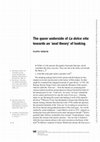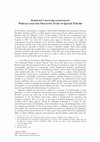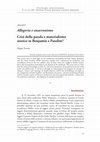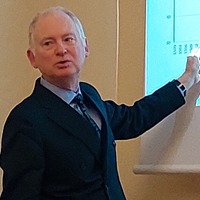Books by Filippo Trentin
Until the mid-twentieth century the Western imagination seemed intent on viewing Rome purely in t... more Until the mid-twentieth century the Western imagination seemed intent on viewing Rome purely in terms of its classical past or as a stop on the Grand Tour. This collection of essays looks at Rome from a postmodern perspective, including analysis of the city's 'unmappability', its fragmented narratives and its iconic status in literature and film.
Articles by Filippo Trentin

Screen, 2020
In psychoanalytical film theory looking and filming have traditionally been considered to be phal... more In psychoanalytical film theory looking and filming have traditionally been considered to be phallic. Centering upon what Freud referred to as “genital sexuality,” gaze theory’s focus on the phallus has made it difficult for film theory to move away from a binary conception of the gaze based on sexual difference. This essay works to loosen the connection between the camera and the phallus, proposing a queer revision of gaze theory through an exploration of the psychoanalytical links between the camera’s hole and the anus in Federico Fellini’s La dolce vita (1960). Reassessing the role of the gaze in the film that invented the figure of Paparazzo, I argue that looking, photographing and filming are acts constantly traversed by an anal drive that disturbs the phallic framing of looking and more broadly of cinema itself. If feminist film theory has taught us that dominant cinema defines itself by projecting the male gaze upon the body of the Woman as Other, at the same time supporting and perpetuating a phallic power structure based on sexual difference, what a queer reading of La dolce vita reveals is that the click of a camera and the subsequent opening and closure of the photographic objective replicate the shattering movement of the anal sphincter.

GLQ: A Journal of Gay and Lesbian Studies, 2019
This essay excavates from within the history of feminist and queer theory a series of implicit th... more This essay excavates from within the history of feminist and queer theory a series of implicit theories of the couple, ranging from French feminist critiques of asymmetrical heterosexual relationships to triadic accounts of the queer as couple’s sexual and racialized Other. We turn to four integers—one, two, three, and zero— to comprehend the shifting relationship between the Couple and the Queer, constructing a queer numerology that attends to the numerical patterns that can be said to characterize coupled relationality in different historical moments. Taking cues from Lee Edelman as well as recent Afro-pessimist scholarship, we approach the Couple not as a sociological category, but as a structure of being, and the Queer, not as an identitarian category but as an (non)ontological position. Drawing from a diverse archive of texts from 1970s Italian feminism to Daoist philosophy to early psychoanalytic theories of the anus, we take a step back from the post-structural logic that has animated queer studies since its inception, developing a structuralist methodology that insists on the ontological and ethical significance of the position we call the zero.

This article analyses the atlas as a method of classification in literary theory. It investigates... more This article analyses the atlas as a method of classification in literary theory. It investigates the link between the atlas as a form of epistemological organization and the ‘subversive’ and ‘anti-canonical’ use of cartography advocated by the proposers of the spatial turn of literature, including Malcolm Bradbury’s Atlas of Literature, Franco Moretti’s Atlas of European Literature and Sergio Luzzatto and Gabriele Pedullà’s Atlante della letteratura italiana. After assessing the ways in which these works address the dialectics between spatiality and historicity in relation to the constitution of the literary canon, I will move to a discussion of the way in which the atlas as a form of knowledge emerged in 16th century cartography (Abraham Ortelius and Gerhard Mercator). Then, in the final part of the essay, I will engage in an interpretation of Aby Warburg’s Bilderatlas Mnemosyne, which I read as an ‘anatopic’ object that keeps troubling any purely cartographic use of the atlas. In my reading, by theorizing an anti-foundational (and anti-identitarian) method of knowledge organization based on the morphological affect between disparate images and objects, Warburg’s atlas brings to the profanation of the atlas as a topographical machine. My use of the term ‘anatopy’ in this essay is at the same time speculative and heuristic, and aims to capture the disorienting potentialities which are intrinsic in non-cartographic explorations of space.

In this article I will propose a reading of Porcile which underlines the connections between Paso... more In this article I will propose a reading of Porcile which underlines the connections between Pasolini’s aesthetics and the so-called negative turn in queer theory, which stems from Leo Bersani’s and Lee Edelman’s work. In this reading I will take into consideration both versions of Porcile: the play, written in 1967, and the movie, released at the Venice Film Festival in 1969. Not only will I analyse some aspect of Pasolini’s work in light of contemporary theoretical debates, but I will also underline the potential that Pasolini’s work has for solving some of the aporias that emerged concomitantly to the negative turn in queer theory, especially in relation to issues of political viability. Thus, while reading Porcile through queer theory might allow us to understand better the complex ways in which aesthetics intersect with politics and sexuality in Pasolini’s late work, reading queer theory through Pasolini might allow us to focus on what is really at stake with controversial notions such as anti-sociality and ‘no future’.

This article focuses on the emergence of a dystopian imagery of Rome in Fellini's Toby Dammit and... more This article focuses on the emergence of a dystopian imagery of Rome in Fellini's Toby Dammit and Roma and in Pasolini's Petrolio. In these films and novel, the cohabitation of vernacular and modern elements that had characterized Fellini's and Pasolini's works in the 1960s (Ragazzi di vita and Accattone, Le notti di Cabiria and La dolce vita) suddenly fades away. What surfaces instead is a dissociated and chaotic cityscape that tends toward a state of maximum disorder and to the incorporation of diversity into sameness. I propose an interpretation of this paradigm shift of Rome's imagery through the concept of 'entropy,' which in thermodynamics and information theory refers to a process of gradual decline of a self-enclosed system. I will first discuss the material mutations of Rome's 1960s map through an examination of urban analyses by Benevolo, Cederna, and Insolera, before moving to a close reading of Rome's image in Toby Dammit, Roma, and Petrolio. What I argue is that the process of dissociation and fragmentation of Rome's map theorized in urban studies is replicated at the aesthetic level by the sense of entropic confusion and the loss of spatial coordinates that mark Fellini's and Pasolini's 1970s engagements with Rome.
Questo articolo punta ad analizzare le correlazioni intellettuali tra Walter Benjamin e Pier Paol... more Questo articolo punta ad analizzare le correlazioni intellettuali tra Walter Benjamin e Pier Paolo Pasolini attraverso un'analisi del concetto di allegoria e di materialismo storico all'interno dell'opera dei due autori.
Canonical interpretations and representations of Rome appear dependant on the category of the ‘Et... more Canonical interpretations and representations of Rome appear dependant on the category of the ‘Eternal City’. This essay poses these images as a dominant narrative that guides the ‘archive’ of the city’s images. Drawing on theoretical concepts that threaten the constitution of such an archive, this article reads queer images of Rome as disturbances that go against the ‘eternal’ archiving principle. With reference to Roman Holiday, it illustrates the close intertwining of eternality in Rome with hetero-normativity and reproductive futurity. This connection allows the reading of queer texts and images, such as Gus Van Sant’s My Own Private Idaho and Pier Paolo Pasolini’s novel Petrolio, as what we call ‘Roman Fever’, that is, the deactivation of ‘eternality’ as the central driver of Rome’s archive.
Papers by Filippo Trentin

This essay excavates a lineage of formalist analysis that stretches from the Victorian art critic... more This essay excavates a lineage of formalist analysis that stretches from the Victorian art critic John Ruskin to the early twentieth-century art historians Aby Warburg and Henri Focillon, proposing that a fascination with what Ruskin had called “inessential form” drives these three thinkers’ attempts to conceive of form as immanent to both matter and time. The theories of form developed by these three thinkers, while little cited in literary studies, destabilize many of our field’s present-day assumptions about the role of form in literature, from recent debates about surface versus depth to the longstanding distinctions between historicist and formalist approaches to literary texts. From these art historians we learn that close attention to form is close attention to affect, that is, how emotionally charged energies crystallize, throughout time, into pictorial and sculptural details—flowing hair, intricately sketched earlobes, or billowing garments, for example. Building on their w...

Criticism, 2019
This essay excavates a lineage of formalist analysis that stretches from the Victorian art critic... more This essay excavates a lineage of formalist analysis that stretches from the Victorian art critic John Ruskin to the early twentieth-century art historians Aby Warburg and Henri Focillon, proposing that a fascination with what Ruskin had called “inessential form” drives these three thinkers’ attempts to conceive of form as immanent to both matter and time. The theories of form developed by these three thinkers, while little cited in literary studies, destabilize many of our field’s present-day assumptions about the role of form in literature, from recent debates about surface versus depth to the longstanding distinctions between historicist and formalist approaches to literary texts. From these art historians we learn that close attention to form is close attention to affect, that is, how emotionally charged energies crystallize, throughout time, into pictorial and sculptural details—flowing hair, intricately sketched earlobes, or billowing garments, for example. Building on their work, we advocate for an approach to form in literature not as a fundamental pattern or shape to which the text can be conceptually reduced, but as the capacity of language to be affected by the reality it also shapes
Psychoanalysis and History, 2022
This introduction contextualizes Lou Andreas-Salomé’s 1916 essay ‘“Anal” and “Sexual”’ within ear... more This introduction contextualizes Lou Andreas-Salomé’s 1916 essay ‘“Anal” and “Sexual”’ within early psychoanalytic debates about anal sexuality, narcissism, and subject-formation, and gestures toward its relevance for recent thinking in queer theory and critical race studies. While Andreas-Salomé’s work has often been read as a gloss to Freud’s sexual theory, we emphasize the originality of her contributions to psychoanalytic discourse. Not only did ‘“Anal” and “Sexual”’ impact Freud’s understanding of the long-lasting influence of anal repression on the psyche, but it anticipates the concerns of more recent theorists with how subjects are gendered and racialized through processes of corporeal symbolization.

Forum Italicum: A Journal of Italian Studies, 2016
This article focuses on the emergence of a dystopian imagery of Rome in Fellini’s Toby Dammit and... more This article focuses on the emergence of a dystopian imagery of Rome in Fellini’s Toby Dammit and Roma and in Pasolini’s Petrolio. In these films and novel, the cohabitation of vernacular and modern elements that had characterized Fellini’s and Pasolini’s works in the 1960s ( Ragazzi di vita and Accattone, Le notti di Cabiria and La dolce vita) suddenly fades away. What surfaces instead is a dissociated and chaotic cityscape that tends toward a state of maximum disorder and to the incorporation of diversity into sameness. I propose an interpretation of this paradigm shift of Rome’s imagery through the concept of ‘entropy,’ which in thermodynamics and information theory refers to a process of gradual decline of a self-enclosed system. I will first discuss the material mutations of Rome’s 1960s map through an examination of urban analyses by Benevolo, Cederna, and Insolera, before moving to a close reading of Rome’s image in Toby Dammit, Roma, and Petrolio. What I argue is that the pr...
Psychoanalysis & History, 2022
I would like to thank Manuele Gragnolati and Christoph Holzhey for their attentive and generous r... more I would like to thank Manuele Gragnolati and Christoph Holzhey for their attentive and generous reading of this article, and for their invaluable support during the conceptualization of the broader research project from which this article stems. I would also like to thank Dom Holdaway for his precious feedback on early drafts of this article. This article is dedicated to Marco Cavietti, who first introduced me to Warburg's thought.

This article aims to shed light on the intellectual relationship between Walter Benjamin and Pier... more This article aims to shed light on the intellectual relationship between Walter Benjamin and Pier Paolo Pasolini. While numerous scholars have commented on similarities and resemblances between the two authors, none of these critics has sought to further analyse them, thus leaving their relationship in the domain of the similitude. This essay aims to evolve from the analysis of analogies to that of a «discursive formation» (Foucault) between the works of the two intellectuals. It will do so through an archaeological investigation of concepts of 'allegory', 'history' and 'montage'. Its double objective will be that of shedding a new light on the complexities of both Pasolini's and Benjamin's discourses, and that positioning Pasolini within a broader context of Western intellectuals who investigated the reticular-rather than the positivistic and linear-development of capitalist modernity.

2013 witnessed the production of three films – Paolo Sorrentino’sLa grande bellezza, Gianfranco R... more 2013 witnessed the production of three films – Paolo Sorrentino’sLa grande bellezza, Gianfranco Rosi’s Sacro GRA, and Federico Zampaglione’s Tulpa – all set in Rome and its environments, and all characterized by a remarkable focus on the urban cityscape in its various shapes: the historical city centre (Sorrentino), the ring-road highway around Rome (Rosi), and the EUR district (Zampaglione). It seems, however, that by engaging with specific and recognizeable imaginaries embedded in the fabric of Rome’s cityscape, at the same time these films reactivate aesthetic and cultural traditions –“ghosts,” one might be tempted to say – of Rome’s cinematic representations in the 1960s and 1970s. Whereas Sorrentino’s confrontation with Fellini’s representation of Rome – and most notably with La dolce vita (1960), Satyricon (1969), and Roma (1972) – has been generally highlighted by criticism, Rosi manages to productively reorient the legacy of Neorealism, through the documentary genre, in orde...










Uploads
Books by Filippo Trentin
Articles by Filippo Trentin
Papers by Filippo Trentin